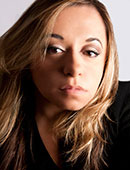Bionic body topic of ELA talk
What does it mean to be human today in a world where technological progress has expanded the abilities of the body?
 Associate Professor Magda Romanska, of Performing Arts, delved into the topic during “The Bionic Body: Representations of Disability in Post-Human Culture,” a public lecture sponsored by the Office of Post-Graduate and Professional Studies at Emerson College Los Angeles on November 17.
Associate Professor Magda Romanska, of Performing Arts, delved into the topic during “The Bionic Body: Representations of Disability in Post-Human Culture,” a public lecture sponsored by the Office of Post-Graduate and Professional Studies at Emerson College Los Angeles on November 17.
“What kind of population will we have in 100 years?” Romanska asked.
To answer that question, Romanska first turned to the past. She explored representations of “human” throughout the ages, touched upon the debate surrounding human enhancement, and discussed various representations of people with disabilities in films.
Romanska identified four ways that people with disabilities have stereotypically been portrayed on film: magical, evil, redemptive, or inspirational. These representations depict a disabled person who is either full of enlightenment, wisdom, and inspiration, or moral and physical disability.
With technological advances, the boundaries of what is and isn’t human have changed. Now, developments in science and technology have enabled those with a bionic body to achieve greater capabilities than other human beings.
“This calls into question the capacities and limits of the abled body,” said Romanska.
As the concept of the bionic body continues to permeate contemporary culture—models display their prosthetic limbs as accessories, bionic tattoos have become fashion statements—it raises questions about how the disabled body should be represented in film, theater, and new media.
The typical narrative of a character with disabilities is for him or her to reclaim human dignity, Romanska said. She suggested that in a post-human landscape, future storytellers assume characters with disabilities already have human dignity and that no other characters are interested in having it.
Among the audience members who attended the lecture was Veronica Montoya, MA ’13, who had a personal interest in the topic.
“I work with different types of people as a speech pathologist,” said Montoya. “I want to know about what’s going on with different disabilities, to be informed.”
Romanska ended the lecture by answering questions from the audience, suggesting it will take a long time for storytellers to change the way people with disabilities are portrayed.
“We’ll see the effect technology will have,” Romanska said.
Categories